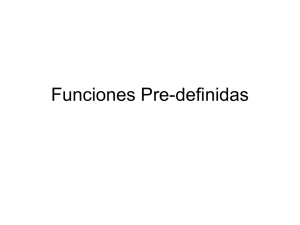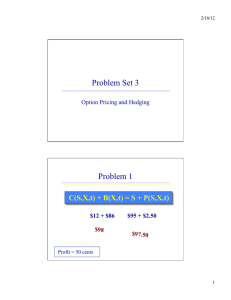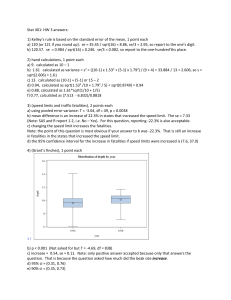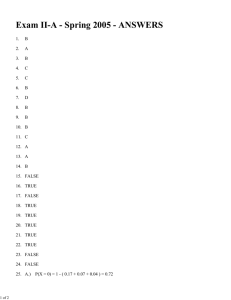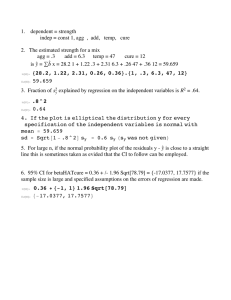Practice QUIZ Problems with Solutions:
advertisement
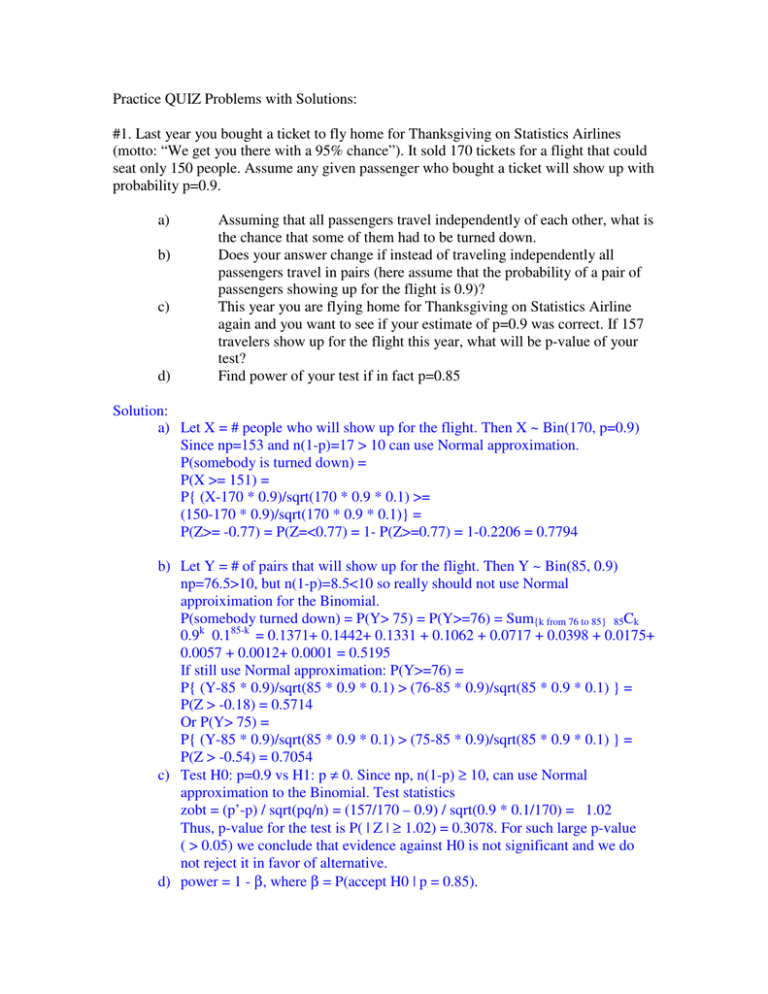
Practice QUIZ Problems with Solutions:
#1. Last year you bought a ticket to fly home for Thanksgiving on Statistics Airlines
(motto: “We get you there with a 95% chance”). It sold 170 tickets for a flight that could
seat only 150 people. Assume any given passenger who bought a ticket will show up with
probability p=0.9.
a)
b)
c)
d)
Assuming that all passengers travel independently of each other, what is
the chance that some of them had to be turned down.
Does your answer change if instead of traveling independently all
passengers travel in pairs (here assume that the probability of a pair of
passengers showing up for the flight is 0.9)?
This year you are flying home for Thanksgiving on Statistics Airline
again and you want to see if your estimate of p=0.9 was correct. If 157
travelers show up for the flight this year, what will be p-value of your
test?
Find power of your test if in fact p=0.85
Solution:
a) Let X = # people who will show up for the flight. Then X ~ Bin(170, p=0.9)
Since np=153 and n(1-p)=17 > 10 can use Normal approximation.
P(somebody is turned down) =
P(X >= 151) =
P{ (X-170 * 0.9)/sqrt(170 * 0.9 * 0.1) >=
(150-170 * 0.9)/sqrt(170 * 0.9 * 0.1)} =
P(Z>= -0.77) = P(Z=<0.77) = 1- P(Z>=0.77) = 1-0.2206 = 0.7794
b) Let Y = # of pairs that will show up for the flight. Then Y ~ Bin(85, 0.9)
np=76.5>10, but n(1-p)=8.5<10 so really should not use Normal
approiximation for the Binomial.
P(somebody turned down) = P(Y> 75) = P(Y>=76) = Sum{k from 76 to 85} 85Ck
0.9k 0.185-k = 0.1371+ 0.1442+ 0.1331 + 0.1062 + 0.0717 + 0.0398 + 0.0175+
0.0057 + 0.0012+ 0.0001 = 0.5195
If still use Normal approximation: P(Y>=76) =
P{ (Y-85 * 0.9)/sqrt(85 * 0.9 * 0.1) > (76-85 * 0.9)/sqrt(85 * 0.9 * 0.1) } =
P(Z > -0.18) = 0.5714
Or P(Y> 75) =
P{ (Y-85 * 0.9)/sqrt(85 * 0.9 * 0.1) > (75-85 * 0.9)/sqrt(85 * 0.9 * 0.1) } =
P(Z > -0.54) = 0.7054
c) Test H0: p=0.9 vs H1: p � 0. Since np, n(1-p) � 10, can use Normal
approximation to the Binomial. Test statistics
zobt = (p’-p) / sqrt(pq/n) = (157/170 – 0.9) / sqrt(0.9 * 0.1/170) = 1.02
Thus, p-value for the test is P( | Z | � 1.02) = 0.3078. For such large p-value
( > 0.05) we conclude that evidence against H0 is not significant and we do
not reject it in favor of alternative.
d) power = 1 - ≥, where ≥ = P(accept H0 | p = 0.85).
At � = 0.05 significance level, we would accept H0 is |zobt| < zcrit(�= 0.025)
= 1.96.
Thus, P(accept H0 | p = 0.85) = P{ -1.96 < zobt < 1.96 | p = 0.85} =
P{ -1.96 < (p’– 0.9) / sqrt(0.9 * 0.1/170) < 1.96 | p = 0.85} =
P{-1.96*sqrt(0.9*0.1/170)+0.9< p’< 1.96*sqrt(0.9*0.1/170)+0.9 | p=0.85} =
P{ 0.85 < p’ < 0.95 | p = 0.85} =
P{ (0.85 – 0.85)/sqrt(0.85*0.15/170) <
(p’– 0.85)/sqrt(0.85*0.15/170) < (0.95 – 0.85)/sqrt(0.85*0.15/170)}=
P{ 0 < Z < 3.65} = 0.5
Thus, power of the test = 0.5
#2. Tanya has invited her friends over for dinner next Friday night. Her cook will have a
day off on Friday (what a bummer!), so Tanya has to choose the menu and cook the meal
by herself. She wants to prepare 3 appetizers, 2 meat dishes and a salad. She knows
recipes for 6 appetizers, 5 meat dishes and 3 salads
a) What is the probability of each possible combination of dishes?
b) In how many ways can Tanya choose the menu for dinner?
Solution:
b)Total # of possible appetizer choices = 6C3 = 20
Total # of possible mean dish choices = 5C2 = 10
Total # of possible salad choices = 3C1 = 3
Thus, total # of possible menu choices = 20 x 10 x 3 = 600
a) Probability of each combination = 1/ {# of possible combinations} = 1/600
#3. An elevator in the athletic dorm at Football College has a maximum capacity of
2400lb.Ten football players get on at 20th floor. Assuming their weights are normally
distributed with mu=220 and sigma=20, what is a chance that there will be 10 football
players fewer at tomorrow’s practice?
Solution:
Let X be weight of 4 football players. Then X ~ Normal (mu=220*10, sigma2 = 202*10)
P(X>2400) = P{ (X-2200)/sqrt(20*20/10) > (2400-2200)/sqrt(20*20*10) } =
P(Z > 3.16) = 0.0008
#4. Suppose Tevye tells you that the scores on the last homework were approximately
normally distributed with a mean of 78 points. Also he tells you that only 10% of the
scores were below 69 points. The top 15% of all scores have been designated as A’s. You
score is 89. Did you receive an A? (These are not real scores, so don’t worry!)
Solution:
Let X be a randomly selected hw score. Then X ~ Normal (mu=78, sigma2).
0.10 = P(X < 69) = P{ (X-78)/sigma < (69-78)/sigma} = P{ Z < -9/sigma}
From z-tables: -9/sigma = -1.28, thus sigma = 7.03
Let XA be the cutoff for getting an A (i.e., everybody with score above XA got an A).
Then 0.15 = P(X > XA) = P{ (X-78)/7.03 > (XA-78)/7.03} = P{Z > (XA-78)/7.03}=0.15
From z-tables find that (XA-78)/7.03 = 1.04 => XA=1.04 * 7.03 + 78 = 85.3
Thus, a person who has a score of 89 gets an A.

